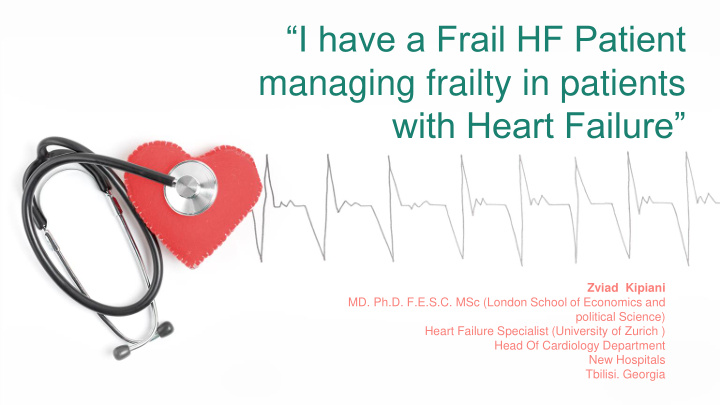



“I have a Frail HF Patient managing frailty in patients with Heart Failure” Zviad Kipiani MD. Ph.D. F.E.S.C. MSc (London School of Economics and political Science) Heart Failure Specialist (University of Zurich ) Head Of Cardiology Department New Hospitals Tbilisi. Georgia
Heart Failure and Problems with Frailty Syndrome: Why it is Time to Care About Frailty Syndrome in Heart Failure
What is frailty? Overview of Frailty Definition Frailty is characterized by reduced physiological reserve and a “loss of functionality leading to an increased vulnerability to adverse stress and health events” (Fried et al, 2001). The first paper that referred to the problem of ‘frail elderly patients’ was published in Frailty occurs more often 1953, and frailty syndrome (FS) was first in older patients with HF described in the 1990s. than in the general older population (Uchmanowicz and Gobbens, 2014) and Frailty is a common syndrome many assessments often found in older people, show a relationship with many of whom also have heart adverse cardiovascular failure . Frailty Syndrome (FS) outcomes. is an independent predictor of mortality in cardiovascular disease . Recognising frailty is crucial because patients with frailty are at higher risk of hospitalisation, functional decline, dependency, falls, fractures, disability and death (Fried et al, 2001).
What is frailty? There are two common models of frailty: The ‘frailty phenotype’ model, which defines frailty as the presence of three or more of five frailty criteria (Table 1);
What is frailty? The ‘cumulative deficit’ model, which describes frailty as an accumulation of deficits, impairments, disabilities and diseases – for example, loss of hearing or tremor – which are used to calculate a ‘frailty index’ (Rockwood and Mitnitski, 2007). Quality of life (QoL) is low in both the HF and the frail populations. Multimorbidity and physical, psychological and social frailty problems have been demonstrated to correlate negatively with QoL Among the most common chronic conditions in the European population are arthritis, diabetes, heart disease, cancer and stroke. Many patients have two or more concurrent chronic diseases, especially those aged 65 years or older. Multimorbidity is associated with hospitalisation, emergency department visits and a reduction in QoL. It is more common in women than men.
Frailty Syndrome Epidemiology Both frailty and HF are common in the elderly population. It is estimated that HF affects at least 26 million people worldwide. The incidence of HF is associated with age — at 65 years, the estimated incidence of HF is 1% and this percentage approximately doubles with each decade of age thereafter. The Cardiovascular Health Study identified that HF was strongly associated with frailty (Newman et al, 2001) and Boxer et al (2008) suggested that frailty was present in 25% of older people with HF. More recently, the FRAIL-HF study showed that up to 70% of patients with HF aged over 80 years also had frailty (Vidán et al, 2014). Patients with both conditions are more likely to have other comorbidities, such as chronic obstructive pulmonary disease, chronic kidney disease, arthritis or anaemia .
Pathophysiology overlap The pathophysiology of frailty (Fig 1), which is poorly understood, revolves around a low- grade chronic inflammatory response, with the production of inflammatory cytokines (C-reactive protein, interleukin-6 [IL-6] tumour necrosis factor alpha [TNFα]) as well as endocrine and neurohormonal involvement (Fedarko, 2011) Alongside this chronic inflammatory state, other biological ageing processes take place. This culminates in muscle inflammation and loss of muscle mass and strength (sarcopenia). Some mechanisms in HF are similar to mechanisms described in frailty (Wohlgemuth et al, 2014). HF is associated with accelerated biological ageing and the same cytokines (for example, IL- 6, TNFα) are implicated. Reduced tissue perfusion from poor cardiac output can affect muscle mass and lead to inflammation. The changes in muscle mass may put patients at further risk of cardiovascular remodelling and dysfunction, with subsequent complications.
Symptom overlap The overlap between the HF and frailty also occurs in clinical symptoms (Fig 2). In both, reduced physical strength and exercise tolerance can compound sarcopenia, which further reduces activity levels (Fried et al, 2001),
Patient management In general, the management of frailty is aimed at preventing, delaying or reversing it, or at reducing its severity. When frailty is not reversible, interventions aim to prevent or reduce the severity of associated adverse health outcomes (Chen et al, 2014). In advanced HF, the reversibility of frailty is unproven, but better HF control and increased activity tolerance can have positive effects on mood and self-care, potentially triggering a virtuous circle of decreasing frailty. Multidisciplinary support Older patients with HF, particularly those who also have frailty, may have poor adherence to medications, poor diet, comorbidities and cognitive impairment (Samala et al, 2011), and will benefit from an interdisciplinary approach to their management (Pulignano et al, 2010). Once frailty has been identified, patients should enter a process of care that involves a comprehensive geriatric assessment (Table 2) undertaken by the multidisciplinary team.
Conclusion Frailty is highly prevalent in HF and there is strong evidence that patients with coexisting HF and frailty have a worse prognosis Assessing frailty is an important aspect of routine care for patients with HF, and it helps to stratify risk and reach clinical decisions The fact that many HF patients also have frailty stresses the need for other specialties to get involved, alongside the multidisciplinary HF team. Frailty should no longer be considered synonymous with aging, furthermore not all patients with HF can be considered frail.
THANKS Does anyone have any questions?
Recommend
More recommend